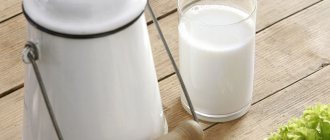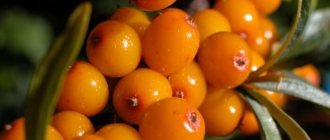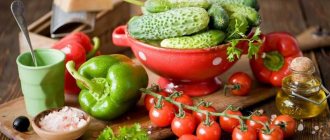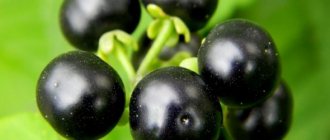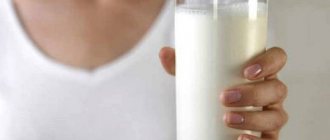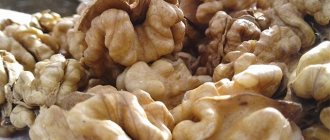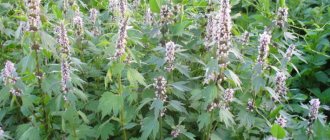Blueberries are the “queen” of northern latitudes. It includes about 100 species of various blueberry bushes and trees. Its distribution area is very wide: it grows in the forest-tundra, taiga, coniferous forests and sphagnum swamps of Europe and Asia, in the Caucasus mountains. The common blueberry, or myrtle-leaved blueberry, is the most common species of this genus. The largest variety of blueberry is a tree growing in the Caucasus mountains - Caucasian blueberry. This tree can reach up to 3 m in height, and its fruits do not have the same coloring properties as blueberries. Blueberries also grow in the forests of North America, but even there they are of Eurasian origin.
What does a common blueberry look like? This is a low-growing shrub that rarely reaches even half a meter in height. The blueberry bush blooms in late May–June, and the fruits ripen by the end of July–August. Its berries are round in shape, up to 8 mm in diameter, and are dark blue with a bluish tinge. The taste of the berries is sweet with pleasant sourness and a slight tartness.
All about the composition of blueberries
Content:
- All about the composition of blueberries
- Beneficial features
- Home remedies
- Dietary supplements and cosmetics
- Hazardous properties
- Use in cooking
- Preparation of blueberries
- Interesting things about blueberries
- conclusions
The benefits of blueberries have been known since time immemorial. The history of the use of blueberries in Rus' dates back to pagan times. It has always been a revered healing agent of shamans and healers. They endowed it with miraculous properties, based on their many years of experience.
The use of blueberries in modern medicine is based on the laboratory-established chemical composition of the berries and the proven effect of the detected substances on the functions of various human organs.
For example, to find out whether blueberries lower or increase blood pressure, a clinical study was conducted in which 80 patients took part. For eight weeks, they drank 1 glass of the juice of these berries twice a day. At the end of the experiment, it turned out that all participants' blood pressure levels decreased.
Why and how is this berry useful? The value of these wild berries lies in their unique composition. The fruits of blueberry bushes contain:
- tannins (gallocatechin, epicatechin, epigallocatechin);
- organic acids (gallic, acetic, tartaric, malic, citric, succinic, quinic, benzoic, lactic, oxalic);
- mono- and polysaccharides (glucose, fructose, sucrose, fiber, pectin);
- fatty acid;
- proteins and amino acids;
- flavonoids and antioxidants (anthocyanins, catechins, leukoanthocyanins, saponins);
- vitamins and vitamin-like substances (ascorbic acid, carotene, B vitamins, rutin);
- macro- and microelements (sodium, potassium, calcium, magnesium, phosphorus, iron, manganese, iodine, chlorine, sulfur).
The calorie content of blueberries is low: 100 g of berries contains 44 kcal. The low calorie content of berries makes it possible to include it in various diets.
In addition to berries, many useful substances are contained in the shoots, leaves and stems of blueberry bushes, so they are also successfully used to make a variety of therapeutic and prophylactic products.
The tannins contained in blueberries belong to the pyrocatechol group. Their high content in berries determines the astringent properties of blueberries. Getting on mucous membranes and wound surfaces, tannins cause partial coagulation of proteins, which leads to their drying and the formation of a protective film on their surface. The concentration of tannins increases in dry berries.
When consuming products containing organic acids, putrefactive and fermentation processes in the intestine are suppressed, as a result of which its own microflora is normalized. They are actively involved in various metabolic processes, due to which they normalize metabolism in the human body. Many organic acids stimulate the secretion of the salivary and other digestive glands and affect the acid-base balance. Some acids have antiseptic and antimicrobial properties.
Simple carbohydrates (glucose, fructose, sucrose) have energy properties, affect the speed of nerve impulses, and participate in the synthesis of cells and tissues of the body. An indigestible polysaccharide - cellulose (fiber) has a number of beneficial properties for the human body:
- absorbs (accumulates) toxic substances from the intestines, thus cleansing the intestines;
- reduces the rate of absorption of simple carbohydrates and cholesterol, which helps reduce their levels in the blood;
- retains water in the intestines, as a result of which the volume of its contents increases and the motility of the intestinal walls is stimulated.
Blueberries contain pectin, which has the ability to bind heavy metal salts and free radicals, which has a detoxifying effect on the body.
The fatty acids contained in blueberry juice are essential. They are represented mainly by mono- and polyunsaturated omega-3 fatty acids, which:
- improve the rheological properties of blood: reduce viscosity, increase blood fluidity;
- have an antioxidant effect;
- reduce the concentration of cholesterol in the blood;
- have hypotensive and anti-inflammatory effects.
The proteins contained in blueberries are sources of essential amino acids in the human body (leucine, isoleucine, valine, phenylalanine).
Blueberry anthocyanin flavonoids (neomirtillin, myrtillin, arbutin) have a hypoglycemic effect, which allows the berries to be consumed by diabetes mellitus and included in various antidiabetic preparations. Arbutin exhibits its antiseptic and antimicrobial properties in an alkaline environment, which is urine in various inflammatory diseases of the urinary system.
Anthocyanins, catechins and leukoanthocyanins are powerful antioxidants and angioprotectors, therefore they are good at restoring impaired microcirculation in tissues, in particular in the eye structures. The scientific literature contains information about the preventive anticancer effect of antioxidants in blueberry extract. Similar antioxidants are also found in blackberries, blue grapes, radishes, and red apples, but the leader in their concentration belongs to blueberries.
The fruits of the blueberry bush are rich in saponins, which have many beneficial therapeutic effects (mucolytic, diuretic, hypocholesterolemic, sedative), and also facilitate the absorption of certain medications when taken simultaneously.
Vitamins and minerals of berries have an immunostimulating effect, normalize metabolism, increase visual acuity, and restore the electrolyte balance of body fluids.
Blueberry plant chemical composition
A rejuvenating berry – this is what people have been saying about blueberries for a long time. The beneficial fruits of the plant contain many antioxidants that help resist stress and fight malignant tumors. The “star berry” has a rich and healing composition.
- Iron, nickel, potassium, magnesium, calcium, copper, phosphorus, cobalt, manganese. Important elements for a healthy human condition.
- Organic acids: ascorbic, citric, malic, oxalic, lactic, succinic, nicotinic, quinic. Take part in metabolic processes.
- Vitamins K, C, B1, B2, B6, E. Provide vital functions of the body and affect well-being.
- Antioxidants prontoanthocyanidin, flavonoid, tannin. Protect human organs from harmful external influences.
- Blueberry carotenoids improve vision.
- Tannins help the heart function.
- Glycosides and polysaccharides regulate blood sugar levels and strengthen the immune system.
- Essential oils normalize the functioning of the nervous and endocrine systems, and even out the water-salt balance.
- Pectin.
- Squirrels.
- Cellulose.
- Carbohydrates.
The vitamins in blueberries satisfy human needs from 2% to 24% of the daily value per 100 g of product. It is especially rich in vitamins K and C.
Ratio of BJU in 100 grams:
- proteins – 1.1 g;
- fats – 0.6 g;
- carbohydrates – 7.6 g.
There are dietary fiber - 3.1 g and water - 86 g.
Beneficial features
The health benefits of natural blueberries are undeniable. The unique balanced chemical composition of blueberry fruits, shoots and leaves determines a wide range of beneficial properties of this plant. These include:
- antibacterial;
- antiseptic;
- anti-inflammatory (suppresses foci of inflammation);
- immunomodulatory (stimulates the immune system);
- hypocholesterolemic (lowers cholesterol in the blood);
- hypoglycemic (reduces blood glucose levels);
- hypotensive (reduces blood pressure);
- mucolytic (thin the sputum);
- astringents (dries the wound surface);
- antioxidant (prevents lipid peroxidation and cell damage by free radicals);
- hepatoprotective (protects liver cells);
- angioprotective (protects vascular walls);
- improving microcirculation in tissues;
- hematopoietic (increases the level of hemoglobin in the blood);
- anti-burn;
- wound healing;
- sedatives.
This range of beneficial properties makes it possible to use blueberries or products made from them internally as one of the means of complex treatment:
- eye diseases (cataracts, night blindness, uveitis, retinopathy);
- diseases of the cardiovascular system (atherosclerosis, arterial hypertension, coronary heart disease, thrombosis, varicose veins);
- iron deficiency anemia;
- metabolic disorders (type 2 diabetes mellitus, gout, obesity);
- neurological pathologies (senile dementia, Alzheimer's disease);
- inflammation of the oral cavity and pharynx (stomatitis, gingivitis, tonsillitis);
- kidney diseases (urolithiasis, chronic pyelonephritis and glomerulonephritis);
- diseases of the digestive tract (stomach, intestines, liver and pancreas).
Blueberries have an effective effect on stool. At the same time, you need to know how to eat the berries so that they have the desired effect. Whether blueberries will strengthen or weaken depends on the method of harvesting the raw materials:
- fresh berries are indicated for constipation, as they increase intestinal motility;
- dried berries help against diarrhea because they reduce intestinal motility.
External use of products containing blueberry raw materials is indicated for:
- inflammatory processes on the skin;
- age-related changes in the skin (aging, sagging, aging skin);
- scarring changes on the skin;
- varicose veins;
- hyperpigmentation.
Regular consumption of blueberries has been proven to help against cancer (reduces the incidence of blood, breast and colon cancer) due to their high antioxidant content.
Characteristics of blueberries
Dark alpine fruits have been known to people for a long time. Wild blueberries, along with currants, served humanity as an indispensable source of vitamins and acid.
Today, the crop is actively grown at home, but the wild variety is considered more useful in terms of its chemical composition.
The scientific name of the variety is Vaccinium myrtillus. The product received this name due to the suitability of the leaves for consumption by livestock: vacca means cow in Latin. The Slavic name was formed due to the fact that the berries are painted black.
Appearance
The berries have a round, sometimes oval shape. The diameter of the fruit varies from 6 to 10 millimeters. A characteristic feature of the variety is a waxy coating that makes the skin shiny and smooth.
The color of blueberries is predominantly dark blue, sometimes black. At the bottom of the berry there is a crown. The fruits contain a large number of seeds - up to 40 pieces.
Taste and smell
The taste of blueberries is rich, sweet and sour. The berries can be compared to currants and gooseberries. A similar plant is blueberries, but these fruits differ greatly in taste. Blueberries are more sour and flavorful. The product also has a weak astringent effect and stains the oral mucosa.
The odor of the fruit is often described as faint but persistent. Also, the aroma increases several times when the integrity of the berries is violated.
Composition and calorie content
The berries have a complex chemical composition - the product contains not only many vitamins and minerals, but also a large amount of essential oils. Vitamin composition of fruits:
- B vitamins;
- beta-carotene;
- ascorbic acid;
- tocopherol;
- vitamins K and PP.
The variety also contains microelements:
- copper, manganese and iron;
- zinc and selenium;
- phosphorus, magnesium and calcium;
- chromium;
- sodium and potassium.
The properties of blueberries, unique to the human body, lie in a huge number of different acids. In addition to ascorbic acid, fruits contain:
- lemon;
- cinchona;
- amber;
- vinegar;
- dairy
Due to their high acid content (up to 7%), blueberries have antibacterial properties. The leaves of the plant contain myrtilline, neomyrtilline and flavonoids. These compounds reduce sugar levels in the body.
The glycemic index of berries is 43 units. The calorie content of the product is also quite low - 40 calories per 100 grams.
Home remedies
Fresh berries can be used as a home remedy. It has been established by evidence that for adult eye health, the norm is to consume 50-150 mg of anthocyanins from food every day. This amount of these substances is contained in 15-20 g of fresh blueberries. Exceeding this daily amount does not increase the effect, but the likelihood of side effects, for example, darkening of tooth enamel, increases.
You can make eye drops from the juice of fresh berries. To prepare them, you need to mash 2 tablespoons of fruits in a porcelain bowl to obtain juice. The juice is filtered through cheesecloth or a fine sieve to remove seeds and diluted with sterile distilled water purchased at a pharmacy in a ratio of 1:2. The prepared solution must be poured into a boiled bottle. Keep refrigerated. These drops are used for diseases of the cornea or conjunctiva, instilling 2-4 drops of blueberry solution into each eye daily.
The juice of fresh berries can be used to make compresses on the skin for wounds or burns. The procedure should be performed daily at least three times a day.
You can make a compress from dried berries, similar to a compress from the juice of fresh berries. A blueberry extract is prepared for it: 100 g of dried berries are poured into 0.5 liters of boiling water, wrapped in a towel and left for half an hour, after which the infusion is boiled. After cooling, the broth is filtered and used for compresses.
When you have a cold and to strengthen your immune system, you can brew healthy blueberry tea, which can successfully replace regular black or green tea in the cold season. How to brew blueberry tea so that it remains healthy? To prepare it, pour 100 g of dried berries or leaves with one liter of water at room temperature, put on low heat and cook after boiling for 10 minutes. After this, the broth is wrapped and infused for half an hour. The drink turns out aromatic and healthy. To normalize sleep, you can drink this tea before bed with honey or mint.
Benefits and harms of blueberries
The amazing composition of the berries indicates the benefits that the product brings to the human body. Alpine fruits are known for the following properties:
- Antibiotic. Blueberries are a natural antiseptic and are good at removing any inflammatory processes in the body.
- Disinfection. The composition of the berries allows them to regulate the intestinal microflora and destroy harmful bacteria.
- Removing toxins. The fruits cleanse the body, improving the overall well-being of a person.
Infusions from the leaves of the plant are used to strengthen the immunity of people who have been in a zone of increased radiation. Also, decoctions are widely used to accelerate the regeneration of the epidermis and the healing of the skin without scars.
Separately, it is worth noting the honey made from blueberry blossoms. This product is distinguished by its high taste and presentable appearance: it is liquid, transparent, with a slight reddish tint.
Honey retains many of the beneficial properties of the berries, as well as the blueberry flavor and aroma.
Beneficial properties for a woman’s body
Since ancient times, the fair sex has used not only fresh blueberries, but also other parts of this plant to improve health. The product is used for various purposes:
- Masks and creams are made from the fruit to improve skin condition. Blueberries help get rid of rashes on the face and even out your overall tone.
- Women of all times have taken berries to slow down aging. The product has been proven to accelerate cell regeneration.
- Eating fruits reduces the pain of menstruation. The variety is also used to regulate the female cycle.
- Berries reduce the risk of cystitis and other diseases of the genitourinary system.
The product is often used as a hair mask. Blueberries gently get rid of dandruff and strengthen the bulbs.
The berries are good for getting rid of female varicose veins, in particular postpartum ones. The variety improves the elasticity of blood vessels and helps them return to normal.
Benefits and harms to men's health
For males, blueberries will also serve as a useful source of vitamins. Flavonoids contained in berries affect male libido - it has been proven that consumption of fruits improves reproductive function in men.
The variety also has a good effect on the cardiovascular system. Berries improve the elasticity of blood vessels and reduce the risk of blood clots.
A decoction of blueberry leaves helps prevent prostate cancer. The infusion has shown itself well in the fight against prostatitis.
Variety for pregnant women: benefits and contraindications
For pregnant girls, the product will help in the fight against respiratory inflammatory infections. Blueberries are a natural remedy with an antibiotic effect. It is used for colds in pregnant women, since strong medications are contraindicated during this period.
Carrying a child has a negative impact on the condition of teeth and hair - calcium is actively washed out in the female body. In this case, blueberries will serve as a natural dietary supplement that regulates the amount of minerals and nutrients in the body.
Be sure to read:
Yagmei - Chinese strawberry with a spicy taste
However, frequent use of the product can cause gastrointestinal upset in pregnant girls. To avoid this situation, it is recommended to take berries in small quantities after meals. Such measures will prevent an increase in acidity.
Blueberries during breastfeeding
Alpine berries can be consumed during breastfeeding if the mother does not have individual intolerance. A similar supplement should be included in the diet if the product is consumed frequently during pregnancy.
The variety helps a woman’s body recover after bearing a child. Blueberries also have a good effect on the skeleton of a newborn, strengthening bone tissue. The product is not hypoallergenic, but you should start introducing it into your diet carefully. It is better to eat no more than 3-4 berries at first and observe the baby’s reaction.
Blueberries for children
For children under three years of age, the product should be given carefully - no more than 50 g per day, however, at an older age, the fruits will only benefit the child. As a supplement, berries are included in the menu of children with poor weight gain - the variety accelerates the growth of muscle mass.
Milk with blueberries has a particularly good effect on a child’s body. This drink is aimed at the absorption of calcium and beneficial microelements.
The fruits also strengthen the immune system of babies. Grinded with sugar, they are added to the daily diet of children as a prevention of respiratory diseases.
The product is widely used to normalize the children's gastrointestinal tract. However, you should give it carefully if you have constipation - blueberries have an additional strengthening effect.
Contraindications to the product
The fruits are practically incapable of causing serious harm to the human body. Among the possible cases, the effect of berries on the gastrointestinal tract is noted - if a person is prone to ulcers, the consumption of berries should be limited.
It is also necessary to take into account that the variety accumulates toxins and harmful substances from the environment. Berries from contaminated areas can cause serious poisoning.
Dietary supplements and cosmetics
The beneficial properties of blueberry raw materials are used by pharmaceutical manufacturers to produce all kinds of biologically active additives (dietary supplements). Biological products containing blueberry plant raw materials are intended for different groups of potential consumers and, as a rule, have a “narrow specialization”:
- for women (normalize the menstrual cycle, stimulate the female reproductive system);
- for men (increase potency, improve sperm quality);
- for pregnant women (reduce blood sugar levels, dull the feeling of hunger, increase hemoglobin in the blood);
- for diabetics (have a hypoglycemic and diuretic effect, strengthen the walls of blood vessels in the eyes and kidneys, reduce blood cholesterol levels in diabetes);
- for immunity (enrich the body with vitamins, minerals and antioxidants);
- for vision (improves microcirculation in the vessels of the retina, heals microtraumas of the cornea, saturates the body with “visual” vitamins A and );
- for blood (thin the blood, stimulate hemoglobin synthesis);
- for memory and normalization of sleep (improves cerebral circulation, slows down the aging process of neurons);
- for the heart (lower blood pressure, protect myocardial cells from damage by free radicals);
- for blood vessels (strengthens the walls of blood vessels, reduces cholesterol levels in the blood, prevents thrombosis);
- for weight loss (enrich the body with vitamins and minerals, normalize stool during a diet).
For ease of use and dosage when taken orally, dietary supplements are available in the form of:
- blueberry tablets;
- capsules;
- dragee;
- syrups;
- extracts;
- concentrates;
- herbal teas
To enhance the effect of the beneficial substances of blueberries, minerals, vitamins, fatty acids and other beneficial substances are additionally added to the preparations.
Preparations with blueberries that are popular on the modern dietary supplement market include:
- “Evalar blueberry forte with zinc”;
- “Strix forte”;
- “Visivit”;
- “Doppelhertz active with lutein and blueberries”;
- “VIS blueberry extract”;
- “Flax fiber with blueberries”;
- dragee “Tentorium blueberry”;
- herbal tea “Gluconorm with blueberries”.
The composition of these products differs depending on the age, gender, physiological state of the consumer and the purpose of their use. How to drink these products so that they have a positive effect and do not cause poisoning, you must read the instructions attached to them. To be sure of the authenticity of these products, they must be purchased at a pharmacy.
Blueberries are also popular among cosmetics manufacturers. In the cosmetic field, based on substances obtained from blueberry raw materials, cosmetics are produced for the face, for the skin around the eyes, and for hair. These are all kinds of serums, oils, creams, masks, soaps, shower gels, shampoos for different skin and hair types. Most often, these products, in addition to substances from blueberry raw materials, contain additional components that are designed to enhance the effect of blueberries (for example, blueberry cream with hyaluronic acid and collagen for mature skin).
This demand for blueberries in cosmetics is explained by their ability to:
- relieve inflammation;
- regenerate skin;
- improve skin microcirculation;
- normalize lymphatic drainage from subcutaneous fat;
- soften and nourish the skin.
In addition to cosmetic products for hair and skin care, the beneficial properties of blueberries are also used by manufacturers of decorative cosmetics (for example, the use of blueberry seed oil in the production of lipstick).
Blueberry calories
The rich composition and benefits of wild berries are obvious. How many calories are in blueberries? The product is considered low-calorie, as it contains only 44 kcal per 100 grams.
When frozen, blueberries retain all their properties. The calorie content of frozen fruits is even lower: 39.4 kcal. Protein – 0.5 g, fat – 0.6 g, carbohydrates – 8 g, dietary fiber – 3.1 g, water – 86 g.
The glycemic index is calculated based on how quickly carbohydrates are digested and increase blood sugar levels. For blueberries, this indicator is low - only 53, so it is used by diabetics, supporters of a healthy diet and those losing weight to control appetite.
Hazardous properties
Before using dietary supplements or other products containing blueberry raw materials, you should consult your doctor about the possibility of their use. Contraindications for consuming blueberries and products made from them are:
- individual intolerance (can manifest itself in the form of nausea, vomiting, diarrhea, allergies);
- allergic reactions in the patient's history (rash, itching, urticaria);
- simultaneous intake with vitamin C or foods containing it in large quantities - raspberries, wild strawberries, strawberries (benzoic acid contained in blueberries, when interacting with ascorbic acid, forms a carcinogen);
- urolithiasis, gout (oxalic acid can increase oxaluria - an increase in the concentration of oxalic acid in the urine, which leads to the formation of oxalate stones);
- acute pancreatitis (increased secretion of the pancreatic glands can worsen the patient’s condition with pancreatitis);
- acute cholecystitis and exacerbation of cholelithiasis (increased motility of the smooth muscles of the gallbladder and ducts, together with an increase in the secretory function of liver cells, can lead to blockage of the bile ducts with stones);
- hyperacid gastritis and peptic ulcer (blueberries increase the acidity of gastric juice, therefore they are prohibited for consumption with gastritis with high acidity and with peptic ulcer).
To avoid side effects of blueberry products, it is necessary to limit its consumption during pregnancy. It should not be given to infants and children under one year of age.
Women who are breastfeeding (BF) should consume blueberries with great caution, especially in the first month of breastfeeding. Taking blueberries by a nursing mother during breastfeeding can lead to allergic reactions or digestive disorders in the child. Therefore, the question of whether blueberries can be consumed by nursing mothers or not should be decided by the doctor after studying the instructions for the drug.
The instructions for use of the drug must include:
- description of the composition;
- characteristics of its effect on the body;
- method of administration and dosage;
- precautions;
- indications and contraindications;
- best before date;
- manufacturer and his contact details;
- information on state registration of the drug.
From the instructions for the drug you can also find out at what age the drug can be given to children.
If for any reason there are no instructions for use or if it contains incomplete information, you should never take such a drug.
Harm of blueberries and contraindications
Harm from blueberries and contraindications for use can most often arise due to individual intolerance to the product or an allergic reaction. In addition, there are a number of features due to which you should refrain from eating berries. The most common of them are described below.
- Abuse of berries or banal overeating. The daily intake of blueberries is no more than 0.5 kg. If you manage to eat more, such an oversight will lead to an upset stomach.
- When eating blueberries, especially when following a blueberry diet, it is recommended to avoid berries such as raspberries, strawberries, cloudberries and wild strawberries.
- If you have diabetes, consume blueberries only with your doctor's permission.
- It is contraindicated to eat the berry for people suffering from pancreatitis or urolithiasis, since blueberries contain oxalic acid.
- It is harmful to eat berries for people who have pancreatic diseases.
It follows from this that there are no many contraindications, and the consequences of overeating are minimal. However, remember that if you buy products containing blueberries, this does not guarantee their unconditional usefulness. This is especially true for store-bought blueberry juices, the benefits of which and the actual content of berries in the product are very questionable.
Nutritionists recommend adding blueberries to your dishes yourself.
© rintemps — stock.adobe.com
2K 0 Recipe for stuffed tomatoes with minced beef
- #second course
- #beef
- #baking
- #greenery
- #meat
- #dinner
- #roasting
- #vegetables
- #olive oil
- #tomato
- #onion
- #spices
- #dinner
- #stuffed
- #garlic
show more
Use in cooking
The taste qualities of blueberries allow them to be used in cooking for preparing various dishes:
- sweet soups;
- gravy and sauces for meat;
- desserts;
- compotes and jelly.
Every housewife can easily find something to make from blueberries to please her household.
The healthiest thing to do is start every morning with oatmeal and blueberries. To prepare it, you need to bring the milk to a boil, add oatmeal and sugar to taste. You need to cook the porridge for 5 minutes over low heat, stirring constantly. At the end of cooking, add butter and stir. Place the finished porridge on a plate and sprinkle with fresh or frozen blueberries. This breakfast strengthens the immune system and increases vitality.
Blueberry jelly will help enrich the body with vitamins, minerals and antioxidants and improve digestion. To prepare it you need to take:
- a glass of blueberries (fresh or frozen);
- 200 g sugar;
- 3 tablespoons starch;
- 2 liters of water.
Place the berries in a saucepan with water, add sugar, stir and put on high heat. While the broth is boiling, you need to dilute the starch in water. After boiling, the compote needs to be cooked for about 15 minutes, then strain. The strained compote should be brought to a boil, then pour the diluted starch into it. Stirring, bring the jelly to a boil and cook over medium heat for 2-3 minutes.
Applications of berries
Blueberries are widely used in various areas of human life. The product has a unique chemical composition and pleasant taste, so the variety is used both in cooking and in medicine.
In cooking
Many delicious and healthy dishes are prepared using blueberries. Most often, the ingredient is used to make desserts - blueberry muffins and pies are the national pride of many English-speaking countries.
The berry goes just as tasty with poultry. But sweet and sour blueberry sauce goes well with veal and pork steaks.
Be sure to read:
Unusual properties of dogwood
Smoothies and ice cream are prepared based on the product. Blueberries are also used as decorations and salad dressings.
In cosmetology
Blueberries are widely used as an anti-aging agent. The leaves and roots are used to prepare decoctions and infusions that tighten the skin.
Berries often become the basis of various masks and creams. Such products are suitable for almost any skin and, depending on the accompanying ingredients, can both nourish dry epidermis and remove oily sheen.
Blueberries are used to break down fat deposits on the hips and abdomen. The plant removes cellulite and smoothes the skin.
In medicine
In folk medicine, there are many recipes in which the main ingredient is alpine berry. Among them are:
- To combat conjunctivitis. 1 tablespoon of dry blueberries per day helps to cope with this problem.
- Treatment of myopia. The juice from the fresh product is diluted with water in a ratio of 1 to 2 and 5 drops are dropped into the eyes every morning.
- Help with diabetes. This disease is treated with a collection of nettle leaves, blueberries and dandelion root. All ingredients are poured with boiling water and left for an hour. The product is used three times a day
- Fighting gout. Alpine berries (80 g) are poured with a liter of water and heated in a steam bath for an hour. The infusion is taken five times a day, a tablespoon.
There is also a drink that boosts immunity. It is classified as a general tonic medicine. To prepare it you will need both berries and blueberry leaves. Pour boiling water over all ingredients and let it brew. The decoction is taken 3 tablespoons after meals.
Preparation of blueberries
Best materials of the month
- Coronaviruses: SARS-CoV-2 (COVID-19)
- Antibiotics for the prevention and treatment of COVID-19: how effective are they?
- The most common "office" diseases
- Does vodka kill coronavirus?
- How to stay alive on our roads?
To prepare blueberry remedies at home, the berries can be purchased from suppliers, grown in your garden, or collected yourself in the forest.
The most difficult way is to cultivate blueberries in a personal plot. Blueberries are a rather finicky shrub, so planting them must be taken very seriously: study special literature, prepare the soil. To grow it yourself, you need to purchase a garden variety blueberry bush. When planting, the root of the shrub should contain a lump of soil.
You need to buy blueberries at specialized fairs or from large suppliers in markets. There, the raw materials undergo radiological and toxicological control. To buy high-quality blueberries, you need to know how to choose them correctly:
- You need to buy blueberries during their harvest season.
- Berries must be dry when purchased.
- Blueberries should not have a sour smell - this is a sign of spoilage.
- Try a few berries: they should not be bitter. Why are blueberries bitter? Bitterness in berries can appear when honeysuckle, which has a bitter taste, gets into the mass of berries, or when the berries spoil.
- You cannot buy blueberries at spontaneous markets - it is dangerous to your health!
Self-picking of fresh berries is popular among the population of our country. To go pick this berry yourself, you should find out when blueberries ripen in this area. Whether blueberries will be beneficial or harmful depends on the conditions under which they are collected. In order for blueberries to show all their beneficial properties, you need to know where to collect, how to collect and how to store the raw materials of this plant. The chemical composition of the raw material depends on where the shrub grows. Blueberries collected in environmentally unfavorable areas can be harmful to health. Therefore, it needs to be collected in the forest far from industrial zones, roads and railways, livestock grazing areas, landfills, sedimentation tanks, and agricultural lands.
After picking blueberries yourself, there are always a lot of leaves among the berries, so you need to sort through the harvest. How to sort blueberries quickly? A simple device made of an inclined rough surface (cardboard, board or thick fabric) with slats on the sides converging downward will help with this. The berries will roll down the inclined surface, but the leaves and crushed berries will remain on the surface.
How to preserve the beneficial properties of berries? Blueberries retain the maximum amount of nutrients:
- frozen;
- dried (you can also dry blueberry leaves);
- grated with sugar.
Do I need to wash berries before harvesting? The answer to this question depends on the harvesting method. Before drying or canning blueberries, they must be washed. If you decide to freeze the berries, you should not wash them: they may burst when frozen.
You can also make preserves from blueberries (juices, compotes, jams, preserves, syrups). It should be borne in mind that heat treatment partially destroys the beneficial substances of the berries. A popular and tasty blueberry preserve that can be used all year round is jam, for example, blueberry jam with citric acid.
To prepare it you will need the following ingredients:
- blueberries – 1 kg;
- sugar – 1.5 kg;
- water – 0.2 l;
- citric acid – 1/3 teaspoon.
The berries for jam are washed and thrown into boiling water for 3-4 minutes. At this time, prepare sugar syrup. When the sugar is completely dissolved in water, the prepared berries are poured into it. Cook the jam over medium heat for 5 minutes, then turn off the heat, add citric acid and pour into sterilized jars. This method of making jam is gentle on the beneficial substances contained in the berries.
What are blueberries
Where do blueberries grow? Its habitat is the subarctic zone, taiga and mixed forests of northern Europe, Asia and North America. Blueberries are native to North America, where they are called “star berries” because the flowers of the bush resemble a star.
In Russia, bushes with healthy berries are common in coniferous and mixed forests. Because of their love for moisture and shade, blueberries grow near swamps. You can find the berry on a mountain slope. In Rus', blueberry is called the “people's berry” because it is found in almost all regions. The densest and richest blueberries are in the Nizhny Novgorod, Chelyabinsk, Leningrad, Tyumen regions, and in the Khabarovsk Territory. Karelia, Siberia, and Trans-Urals are rich in blueberries.
What does blueberry look like?
Blueberries are a blue-black berry in the shape of a ball or ellipse with a diameter of up to 8 mm. In cross section, the fruit is red-violet with many small seeds. Juicy, sweet and sour blueberries have good taste and low calorie content.
The name of the bush and fruit comes from the color of the ripe berries. Anthocyanins, components of the juice, interact with air and darken. Blueberries blacken, that is, they turn clothes and hands black if crushed. Such stains are difficult to wash and remove. This allows you to use healthy berries as a natural, and even safe, dye.
How blueberries grow in the forest
Blueberry is a herbaceous plant. The low shrub has creeping shoots with thin, smooth, finely serrated leaves. Bushes are often arranged in groups, huddling together. There are many such blueberry meadows in pine forests, spruce and mixed forests.
Blueberry bush lives up to 40 years. The first berries ripen after 4 years. The richest harvest appears on plants older than 10 years, which have been actively bearing fruit for 5-7 years. Then the berries become fewer and fewer.
How blueberries bloom and when they ripen
Blueberry blooms with single white-greenish flowers with a pink tint in May-June. The flowers ripen in July–August: blue-black berries in the shape of a ball or ellipse with a diameter of up to 8 mm. The weight of the berry barely reaches 1 g. The juicy pulp is purple with a reddish tint. The taste of the berries is sweet with a slight sourness.
Interesting things about blueberries
Blueberries are so popular that there are many legends about them. Here is one of them. This happened a long time ago, when gnomes lived in the northern forests. These forests were famous for their untold riches. Having learned about them, people began to look for them, searching everywhere. It became dangerous for the dwarves to live next to people, and they left. For a long time they wandered through the forests without a roof over their heads and food. And only a blueberry bush sheltered them, giving them long-awaited protection and food. In gratitude for this, the gnomes settled this bush wherever they appeared.
The Russian name “blueberry” is given to the berry because it stains your hands when the juice gets on them. Having learned about the coloring properties of blueberries, their juice began to be used as a dye for leather and fabrics, and artists began to prepare their own paints from them.
The plant got its Latin name Vaccinium from the word “vacca”, which means “cow”. Blueberries earned this name due to their initial use on the farm: their leaves were fed to livestock, in particular cows.
The healing properties of blueberries
The medicinal properties of the variety allow the berries to be used as a preventive measure for many diseases. One of the known healing properties of blueberries is supporting vision. The glucoside contained in the product reduces the risk of cataracts.
The berries also resist the formation of glaucoma and restore visual acuity.
Natural powder from herbs and leaves is used for weight loss - such a supplement reduces appetite. The product includes:
- horsetail;
- blueberry leaves;
- valerian.
Tea made from the leaves of the plant helps not only reduce appetite, but also speed up metabolism. The drink also improves the functioning of the gastrointestinal tract and helps with ulcers.
What are the benefits of blueberries for the human body?
The beneficial properties of blueberries are manifested in the following:
- has a positive effect on human immunity;
- stimulates brain activity;
- can speed up metabolism;
- removes harmful substances from the body;
- improves blood composition;
- relieves the effects of stress.
How it will help men
- Blueberries for men are recommended for consumption if there are problems in the sexual sphere. Special substances – flavonoids – contained in the berry have a positive effect on potency and help in the treatment of various urinary tract infections.
- The high level of antioxidant compounds gives blueberries the ability to neutralize free radicals that accumulate in the body, which damage DNA chains, which is partly the cause of the development of cancer.
- Dried blueberries quickly and effectively help restore strength and restore vigor after heavy physical activity. This property of the berry may be especially important for men who regularly exercise and lead an active lifestyle.
For women
- Regular consumption of blueberries helps reduce discomfort during the menstrual cycle. The fiber contained in berries helps normalize digestive processes, thereby reducing the likelihood of bloating, heaviness and pain in the intestines with the arrival of “critical days”.
- Blueberries are useful for postmenopausal women because they can lower blood pressure. And the antioxidants contained in the berry prevent the body from absorbing “bad” cholesterol. Thus, blueberries help prevent the development of many diseases of the cardiovascular system, which are especially dangerous in old age.
- Due to the high content of a whole complex of vitamins and antioxidant compounds, blueberries are a source of female youth and beauty. Berries slow down skin aging, promote tissue restoration, and improve blood circulation. Get rid of dandruff, restore strength and shine to damaged, weakened hair.
Contraindications to eating berries
The use of blueberries as a medicine or simply a source of vitamins and microelements is limited by certain contraindications. Among them:
- individual intolerance to individual components that make up the fruit;
- the occurrence of allergies in a breastfed child.
It is not strictly prohibited, but it is recommended to use the berry with caution if you have liver and pancreas diseases.
In these cases, it is better to first consult with your doctor to exclude possible harm to blueberries.
The berry can be dangerous for people taking blood thinning medications; its uncontrolled consumption can provoke bleeding.
Planting blueberries in open ground
The best site for planting blueberries will be one that is located in the shade, under the openwork shade of tall trees. The soil is suitably acidic, and the groundwater should not lie too far from the surface of the site. If such a shrub is planted in a well-lit area, then it will need frequent spraying with water during the daytime. If planting blueberries is carried out in a region with a fairly mild and not too long winter, then this procedure is recommended to be carried out in August–September. In mid-latitudes and colder regions, such a crop should be planted towards the end of the spring period, after return frosts are no longer observed.
If several bushes are planted at once, then a distance of 150 cm should be maintained between them. If there are row spacing, then their width should be at least 250 cm. The size of the planting hole should be 0.6 x 0.6 m, and the depth should be 0.8 m. At the bottom of the pit it is necessary to make a drainage layer; for this, broken brick or expanded clay is used.
Most often, the soil in the garden is not very acidic, so to plant blueberries you will need a special soil mixture. To do this, in the process of preparing the planting hole, the top nutrient layer of soil should be thrown aside. It is combined with peat (2:1), and powdered sulfur is also added to acidify it, using a quarter of a teaspoon per bush. To correct excessively heavy soil, rotted oak leaves or river sand are added to it. It is necessary to completely fill the pit prepared for planting with this soil mixture, then wait 7–15 days, during which time the soil in the pit should have time to settle. In this regard, it is necessary to begin preparing the planting pit 20–30 days before planting the blueberries.
Experienced gardeners recommend purchasing two-year or three-year-old seedlings for planting. Carefully inspect the planting material, the fact is that instead of blueberry seedlings they may sell you blueberries, since these crops are very similar to each other. Before planting a plant, it is necessary that its earthen lump is saturated with water. Before planting blueberries, the soil in the pit must be spilled with acidified water (1 small spoon of citric acid per 10 liters of water), 1 bucket of the mixture is taken per 1 hole. Then the surface of the soil needs to be loosened and a hole made in it. In this hole you should place the root system of the plant, which is very carefully straightened out, while you need to loosen the earthen lump. The hole must be filled with acidified soil mixture. When the plant is planted, the soil around it should be compacted, and the shrub itself needs abundant watering. When the water is absorbed into the soil, its surface should be covered with a layer of mulch (sawdust or fallen leaves).
If seedlings are planted that are more than 3 years old, then when they are planted, their branches are shortened to 20 centimeters. This will allow the blueberries to take root faster and better in their new location.
How to plant blueberries correctly. Natural farming
The benefits of berries in the treatment of diseases
Diabetes
Blueberries are not prohibited for diabetes, and in some cases are indicated for use as a source of important vitamins and minerals.
Diabetics are recommended to eat not only the fruits, but also the leaves of blueberries, since the individual components contained in the above-ground part of the plant help maintain the balance of glucose in the blood, preventing sudden jumps in its level.
The medicinal properties of blueberry leaves are revealed to the maximum in medicinal infusions prepared from them. The recipe for one of them looks like this:
- 1 tbsp. pour a spoonful of crushed leaves into 1 cup of boiling water.
- The liquids are allowed to stand for 5 minutes.
- Boil in a water bath for 40 minutes.
- After removing the broth from the heat, allow it to cool slightly and filter.
- Take the decoction three times a day, a quarter cup.
Such blueberry treatment for diabetes should be previously agreed with your doctor.
It is important to consider that sweet blueberry syrup or berry jam will definitely not bring any benefit, and can even cause harm to the body of a person suffering from diabetes, so they should be completely excluded from the diet.
Vision problems
Blueberries are actively used to improve vision, prevent and treat various eye diseases. The beta-carotene contained in the fruit is responsible for normal ocular blood circulation and regeneration of retinal tissue.
Due to the high content of this element, the berry and preparations based on it are used in the treatment of night blindness, conjunctivitis, decreased visual acuity and other eye pathologies.
One of these drugs, Blueberry Forte with Lutein, is recommended for use to strengthen the tissues and blood vessels of the eyes, protect the retina from ultraviolet radiation, increase the concentration of vision and relieve fatigue.
Colds
The natural antiseptic and antibiotic properties of blueberry leaves and fruits are excellent in the treatment of acute respiratory infections, influenza and other similar diseases.
Regular consumption of berry decoctions helps to slow down and even stop inflammatory processes in the body, which means it speeds up the patient’s recovery.
Blueberries for colds are used as an auxiliary medicine against pain in the head and throat, and wet cough.
How to store the product
Preparing berries for the winter is not the easiest thing, because after heat treatment, blueberries lose the lion's share of their beneficial properties. However, there are several ways to preserve berries for the cold period:
- Drying. The dried product is very concentrated, it retains most vitamins and microelements. The process itself does not take much time - the product is slightly dried at a temperature of 40°C, and then dried in an electric dryer at 60°C.
- Freezing. This type of fruit processing also allows you to preserve beneficial properties for a long time.
- Conservation. A popular way to store blueberries for a long time is to grind the fruits with sugar. In this form, the product can be preserved or simply left in the refrigerator.
Please note that only fresh product is suitable for long-term storage. Dry blueberries with bitterness indicate the beginning of the fermentation process. Such berries are not suitable for consumption.


